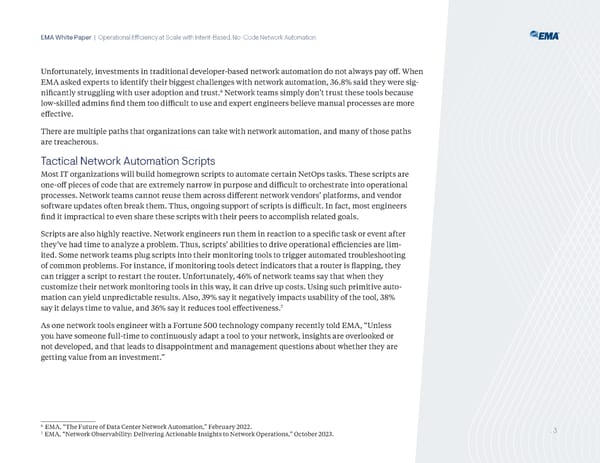EMA White Paper | Operational Efficiency at Scale with Intent-Based, No-Code Network Automation ¡nfortunately, investments in traditional developer-based network automation do not always pay off. ‘hen Š asked experts to identify their biggest challenges with network automation, Ž¢.…‰ said they were sig- ¢ nificantly struggling with user adoption and trust. etwork teams simply don’t trust these tools because low-skilled admins find them too difficult to use and expert engineers believe manual processes are more effective. There are multiple paths that organi ations can take with network automation, and many of those paths are treacherous. Tactical Network Automation Scripts ost IT organi ations will build homegrown scripts to automate certain et†ps tasks. These scripts are one-off pieces of code that are extremely narrow in purpose and difficult to orchestrate into operational processes. etwork teams cannot reuse them across different network vendors’ platforms, and vendor software updates often break them. Thus, ongoing support of scripts is difficult. In fact, most engineers find it impractical to even share these scripts with their peers to accomplish related goals. £cripts are also highly reactive. etwork engineers run them in reaction to a specific task or event after they’ve had time to analy e a problem. Thus, scripts’ abilities to drive operational efficiencies are lim- ited. £ome network teams plug scripts into their monitoring tools to trigger automated troubleshooting of common problems. €or instance, if monitoring tools detect indicators that a router is flapping, they can trigger a script to restart the router. ¡nfortunately, ‡¢‰ of network teams say that when they customi e their network monitoring tools in this way, it can drive up costs. ¡sing such primitive auto- mation can yield unpredictable results. lso, Ž™‰ say it negatively impacts usability of the tool, Ž…‰ ˆ say it delays time to value, and Ž¢‰ say it reduces tool effectiveness. s one network tools engineer with a €ortune “ƒƒ technology company recently told Š, “¡nless you have someone full-time to continuously adapt a tool to your network, insights are overlooked or not developed, and that leads to disappointment and management uestions about whether they are getting value from an investment.” ¢ Š, “The €uture of Ÿata enter etwork utomation,” €ebruary ‚ƒ‚‚. . 3 ˆ Š, “etwork †bservabilityž Ÿelivering ctionable Insights to etwork †perations,” †ctober ‚ƒ‚Ž.
 Operational Efficiency at Scale with Intent, No-Code Network Automation Page 4 Page 6
Operational Efficiency at Scale with Intent, No-Code Network Automation Page 4 Page 6